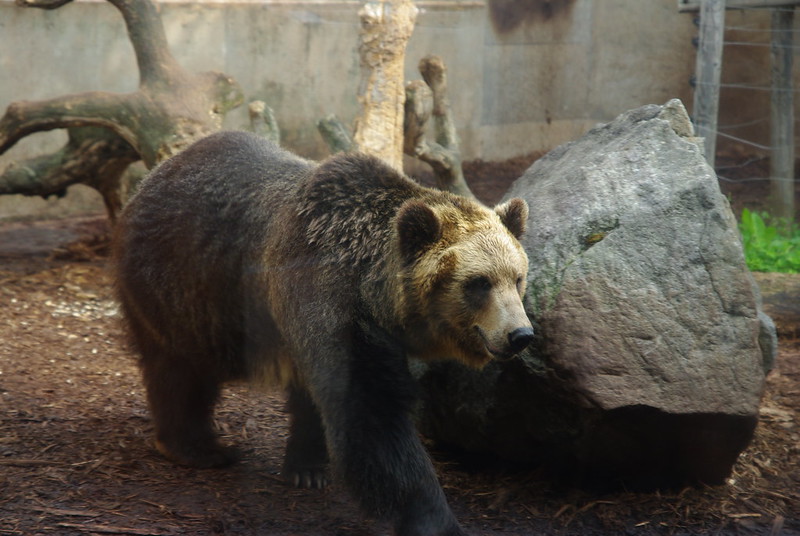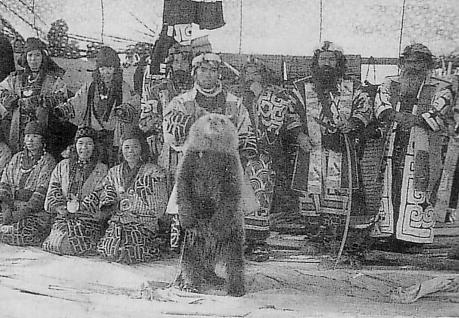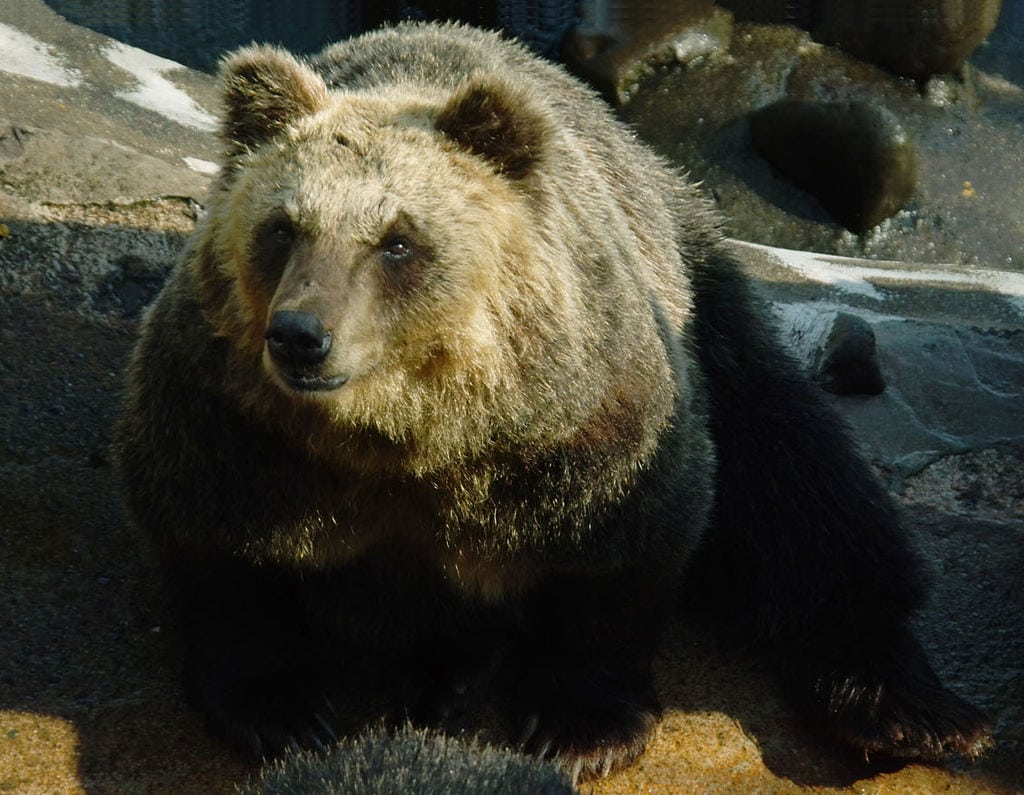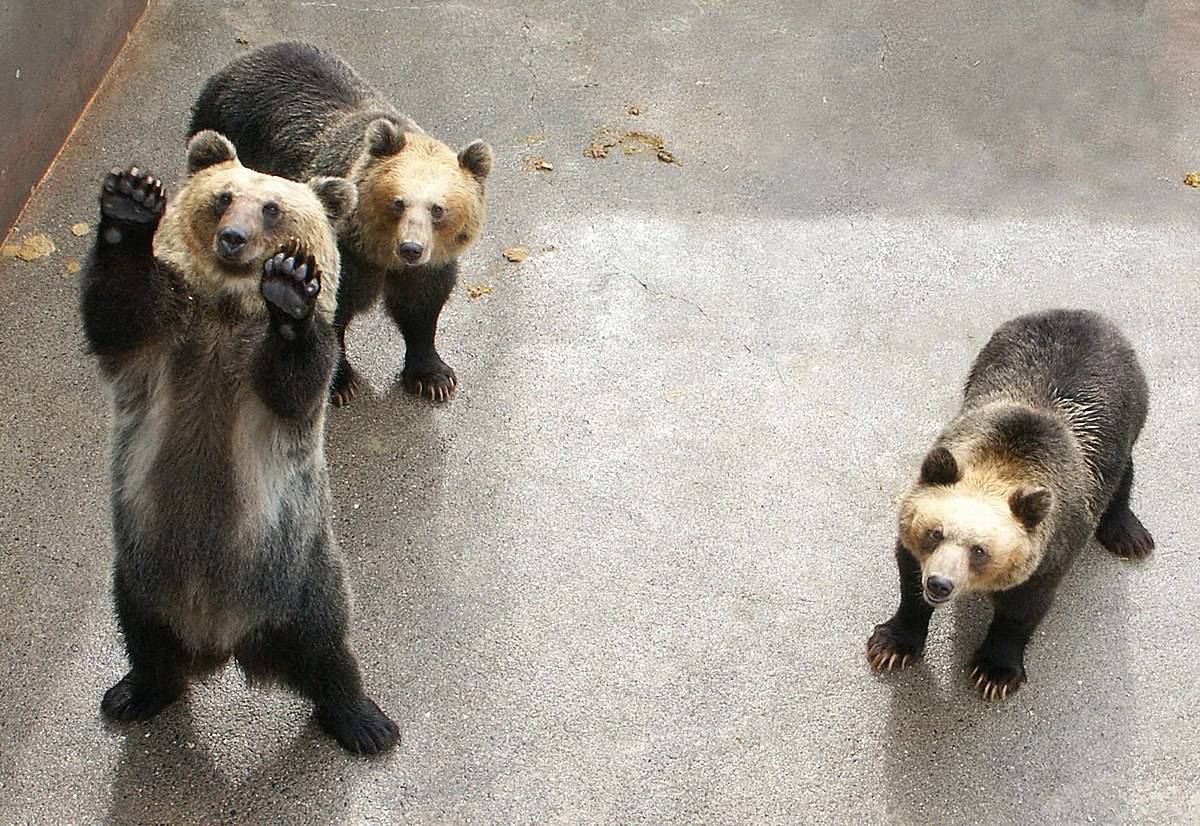| 1 | Brown bears up north, black down south |

Japan has an estimated 2200-6500 brown bears as of 2021, and except for zoos, and pet bears which the police haven’t noticed, they’re all located on the large northerly island of Hokkaido. Meanwhile, the main island of Honshu has no brown bears, but a huge amount of Asiatic black bears.
The reason for this split is a simple quirk of the ocean floor. Despite Hokkaido and mainland Japan being extremely close together, the Tsugaru strait which divides them is extremely deep. Not Marianas trench deep, but deep enough that when sea levels plummeted during the last ice age, no land bridge would have formed between them. However, a land bridge did form between Hokkaido and the far east of Russia, whose remnants survive today as the scattered islands of Kuril.
The black bears, meanwhile, migrated across the South Korean land bridge which fused with Japan in the far south. The species came from totally different directions, but ended up in the same modern day country. It’s theorised that brown bears did migrate to Honshu at one point, but went extinct thousands of years ago, around the late Pleistocene period.
It was this split which helped to foil a classic internet hoax from 2016, when an Australian snowboarder girl was filmed being chased by a brown bear, which anyone below the age of 65 would realise instantly was CGI. She was foiled by poor geographical knowledge – the ski resort was Hakuba47, located on Honshu.
| 2 | Robo wolves |
The Hokkaido wolf has been gone since the 1950s, although strange rumours still persist of howling in the thick woods of Honshu. In 2020, wolves finally returned to the soil of Japan, with one caveat – they were robots running on electricity.
The city of Takikawa, population 40,000, had seen a surge of brown bear sightings in 2020, far above the normal rate of 1 every few years. So city officials did the logical thing, and installed motion sensitive metallic wolves, complete with flashing red eyes and 60 different howling sound effects. They were installed by the Japanese machine maker Ohta Seiki, who claimed that not a single bear attack had occurred since they were installed in September.
Their sales of “Monster robot wolves” had risen to 70 since 2018, and better, there was no evidence of them becoming hyper-intelligent and deciding that humanity was the problem. It wouldn’t be surprising if family visits started to plummet though, because the wolves stand approximately 3 feet tall and would almost certainly give you a heart attack if the light caught them at midnight. The wolves’ voices travel 1km and can also make gunshot sounds and a booming hunter’s voice, covering all the warning sounds that wild bears associate with danger. Some of the robots are used to keep deer and wild boar away from crops as well.
Are you a citizen of bear country? Then robo-wolves could be coming to a town near you, and so could non-stop nightmares.
| 3 | Ancient rituals |

Hokkaido might be part of the heart and soul of Japan today, but it was only officially colonised in 1869. Its original residents were the humble Ainu people, whose traditional dresses and songs survive to the present day. So too does their deep connection with brown bears.
For 10,000 years, bears would be waiting wherever the Ainu people trod: by their fishing sites, enclaves where monkey pear grew, forests where deer lived. They considered brown bears to be the highest of mountain gods, giving them the name of “Kimun Kamui”. One ceremony was the iyomante, or bear-sending ritual, where a mother bear was lured out of her den during winter and killed with two blunt arrows. Her cub would then be raised among the people, hunting with the men and being nursed by the women. Once the cub reached adulthood, the men would spend two weeks carving intricate prayer sticks. Mugwort and bamboo rods would be gathered to burn as incense, and distant villagers would be invited to the upcoming festival.
With a meal of rice and wine, elders would give thanks to Fuchi, the Ainu god of fire and hearth, before two brave men were led into the giant bear’s cave. They would then give him the same treatment as his mother received years earlier, and fire two blunt arrows into his heart, before finishing him off with strangulation and beheading. The bear’s head would be placed on an altar, and the gods would be appeased until next year.
| 4 | Ininkari bear |
Blond bears aren’t uncommon worldwide, from the Syrian brown bear to the grizzlies of Denali national park. But none can compare to the multi-coloured wonders of the Japanese Ininkari bear.
Most of these bears are a standard brown, but there’s also a genetic grouping where the upper half of the body is pure white, with the lower half a mixture of blue and grey. Some Ininkari bears have blue eye patches as well.
Very few Japanese people ever see these bears, as they live in isolation on the remote Kuril islands archipelago, the remnants of the ice age land bridge. Specifically, they live on the islands of Etorofu and Kunashiri, with 130 and 260 bears apiece. There’s no gradual blending of the fur – there’s always an amazingly clear dividing line between the colours of the torso and the lower body. Yet officially, they belong to the Ussuri brown bear subspecies like the rest of Hokkaido’s bears (although they could be a sub-subspecies).
The Ininkari bear has prospered due to having almost no natural predators, minimal hunting pressure due to isolation and reverence for their beautiful fur, and a plentiful supply of fish in the water. They were named in 1791 by none other than Chief Ininkari of the Ainu ethnicity, who painted a beautiful picture which was met with disbelief by western biologists.
| 5 | Slowly turning vegetarian |

The coastline of Hokkaido is swimming with salmon, and the forests are packed with deer. Yet for some reason, Japan’s brown bears have shifted to a vegetarian diet over the last 150 years. Dr Matsuybahsu and colleagues gathered 377 brown bear bone samples from museums and the present day, and concluded that land animals like deer and insects made up approximately 64% of the Japanese bear’s diet until 1920. After 1996, this plummeted to just 6%. Salmon consumption plummeted from 19% to 6%, whereas fruits like crimson glory vine rose from 1% of its diet in 1920 to 64% after 1996.
Add in Japanese staples like sweet coltsfoot and water dropwort, and the newer bears were getting a combined 84% of their diet from plants. What was going on? City development was initially blamed, as before 1920, Hokkaido was largely a rural place of wooden villages. 1996 was selected because it was when the rapid urbanisation of Hokkaido mostly ground to a halt. Throughout the 20th century, dams and waterworks may have prevented the salmon from swimming upstream to their old mountain spawning grounds, leaving the inland grizzlies stumped.
But there’s another equally strong theory: that the extinction of the Hokkaido wolf in the early 20th century left less deer carcasses for bears to steal and feast on. Maybe bears have a secret desire to be cool and are hopping on the new veggie trend. Either way, the bears have adapted well, as their numbers on Hokkaido haven’t declined.
| 6 | Man-bear cooperation |
That said, many Japanese bears are devouring as much salmon as ever, and one example is the Shiretoko peninsula in northeast Hokkaido, a spiky fang with a string of volcanoes running down its spine. Shiretoko is home to 200 bears, and here, something amazing has happened: man and bear are learning to live in harmony.
Shiretoko is a national park, a strictly out of bounds location except for hardy fishermen who rely on generations of father to son teachings. When the bears came-a-knocking in previous decades, they would hire hunters from rustic Hokkaido villages to kill them, or bang oil drums to make a deafening racket. Nowadays, the local bears sit on rocks and eat salmon mere metres away from the fishermen hauling their nets up with cranes. If they get too close, they stare into the bears’ eyes, and speak using “bear language” picked up by watching their gestures.
“It’s a part of our life. Even though bears appear, they just pass by around here” said a fisherman called Mr Oose. Mother bears have been seen walking their cubs through the fisherman’s bases, to get them accustomed to mankind – survival is in their blood, and they’re now passing the secrets to their offspring. The electric fences haven’t been used in years now. Like the Ininkari, the bears of Shiretoko sometimes have an unusual colouring, including a white collar around the neck on an otherwise brown body, like a ceremonial dressing.
| 7 | The horrors of 1915 |

Japan’s most notorious bear incident ever was a 1915 bloodbath, where a brown bear called “diagonal slash” killed 6 people in a rampage near a wooden village. It started in late November when goats began to vanish in the Sankebetsu region of northern Hokkaido. Mr Ikeda wasn’t exceptionally worried, but when Abe Mayu was cooking in the kitchen while watching a friend’s baby, the gigantic bear broke in and dragged her away.
50 men were gathered to defend the village with rifles, but after word of a fresh sighting reached them, they all stood up and dashed to the Ota homestead, leaving the Miouke household with 1 guard. That night, Mayu, wife of Miouke, was cooking when she heard a rumbling sound. Suddenly, the massive bear was rampaging around her house. When Mayu tripped and spilt her soup, it put out the fire, the only remaining source of light.
Mayu escaped the house’s walls, but not before 5 people were mauled to death, including her 3rd son Kinzō. Her husband Miouke was out of town searching for legendary bear hunter Yamamoto Heikichi, who refused to come out of retirement at first, but ultimately trudged into the village 2 days later. A large shadow was sighted by a snowy, icy river, which disappeared at first when they unloaded their bullets into it.
But the next morning, paw prints and blood strains were found. The bear couldn’t last much longer. The once-retired Heikichi followed the pawprints to an old Japanese oak tree, which the injured bear was leaning again. He aimed carefully, and fired a bullet into the bear’s heart, killing it instantly. The bear’s weight was estimated at 749 pounds.
In the years ahead, the Sankebetsu village became a ghost town, and the surrounding highways are still covered with bear symbols and emblems, which are oddly cute-looking.
| 8 | Its zoos are known for cruelty |

In 2018, the BBC reported that 4 Ussuri brown bears had been rescued from grimy, rust-speckled cages in Japan, and shipped off to the UK’s Yorkshire Wildlife Reserve, where they had already gained 6 stone in weight. The bears were aged 17-27, and had been locked in conditions worse than death row since they were cubs. They had been fed nothing but rice, and shockingly, their jail was the Ainu Cultural Museum. Where was the supposed reverence of the Ainu people for bears?
Sadly, this is par for the course in Japanese zoos. Japan has a notoriously bear-fearing population, and many of the zoos were originally rehab centres for cubs orphaned by hunting parties. Gradually though, the owners noticed that families were willing to pay handsome fees for entry, and the centres slowly transitioned into cruel zoos where up to 12 bears are kept in a pit at once. A 2007 report found that Japanese zoo bears were depressed and lethargic, begged for food, and were forced to ride bikes and dress up in clothes.
In one pit, the bears had skin diseases which had destroyed their fur. Little has changed today, as a quick surf of tripadvisor reveals places like Showa Shinzan and Noboribetsu zoos where the horrified visitors leave 1 star reviews and vow never to return. Showa Shinzan has 140 bears, and the operators insist that they’re smiling, waving bears, but in reality, they’re begging for the nuts and apples which visitors are allowed to buy.
| 9 | Recent mayhem |
Generally, Hokkaido is a much more chaotic bear hub compared to Yellowstone or Canada. In 2017 alone, the Japan Bear and Forest Society said that 3779 bears were killed in Japan, including black and brown, with 108 attacks on humans and 2 deaths.
The chaos came to a head in summer 2018. A man’s goat vanished and a pet dog was killed and buried in July, and on August 9th, a bear ventured into the southern Hokkaido town of Shimamaki looking for food. The shining light of a spotlight failed to make it leave; only the loud bangs of firecrackers succeeded.
In 2010, a child pointed out a mother brown bear and cub in the forest by an elementary school. Soon, the big bear family was waltzing down the streets of Shari like they owned the place. Police tried in vain to scare the bears away, as fascinated locals watched on, but when all attempts failed, hunters were brought in to execute them. Just 1 day earlier, a bear had been struck by a train and killed not far away.
More recently, a bear was spotted running down a highway in eastern Hokkaido on March 2nd 2021, keeping an even pace and sticking to the left hand lane. A car followed it and filmed for 30 seconds, believing it was a dog at first, before the bear wisely observed the road rules and made a right hand turn, after checking that no cars were coming.
| 10 | The invasion of Rishi island |

Rishi island is located in northwest Japan and seems to be ripped from a Saturday morning cartoon. It’s completely round, and in its centre lies the extinct volcano Rishiri Fuji. The island only exists because of layer after layer of solidified ash and magma. In 2018, no bears had been sighted in 112 years, but landmarks such as Neguma (sleeping bear) Rock proved that they’d once existed.
Just as the tourist season was about to kick off, gigantic pawprints were spotted on the seashore on May 30th, and the spacing of the claws clearly pointed to a brown bear. 12 camera traps were placed along forest roads, and on June 15th, the islanders captured a real image of the bear and its bright glowing eyes. It was official: bears were back on Rishi Island for the first time in living memory, which was all the more amazing given that the strait to mainland Hokkaido measures 20km at its narrowest point. The bear from 112 years ago was another migrant, who had wandered to the shore, shaken the water from his fur, and been shot dead soon after by hunters.
The 5000 strong population was enraptured for several weeks, but by July 12th, all signs of the bear had vanished. Pots of tempting honey failed to flush him out, and forest officials scoured a Mongolian oak forest packed with classic bear foodstuffs like acorns and salmon. Officials announced that there was a 99% chance that the bear had gone home – until next time.

Leave a Reply